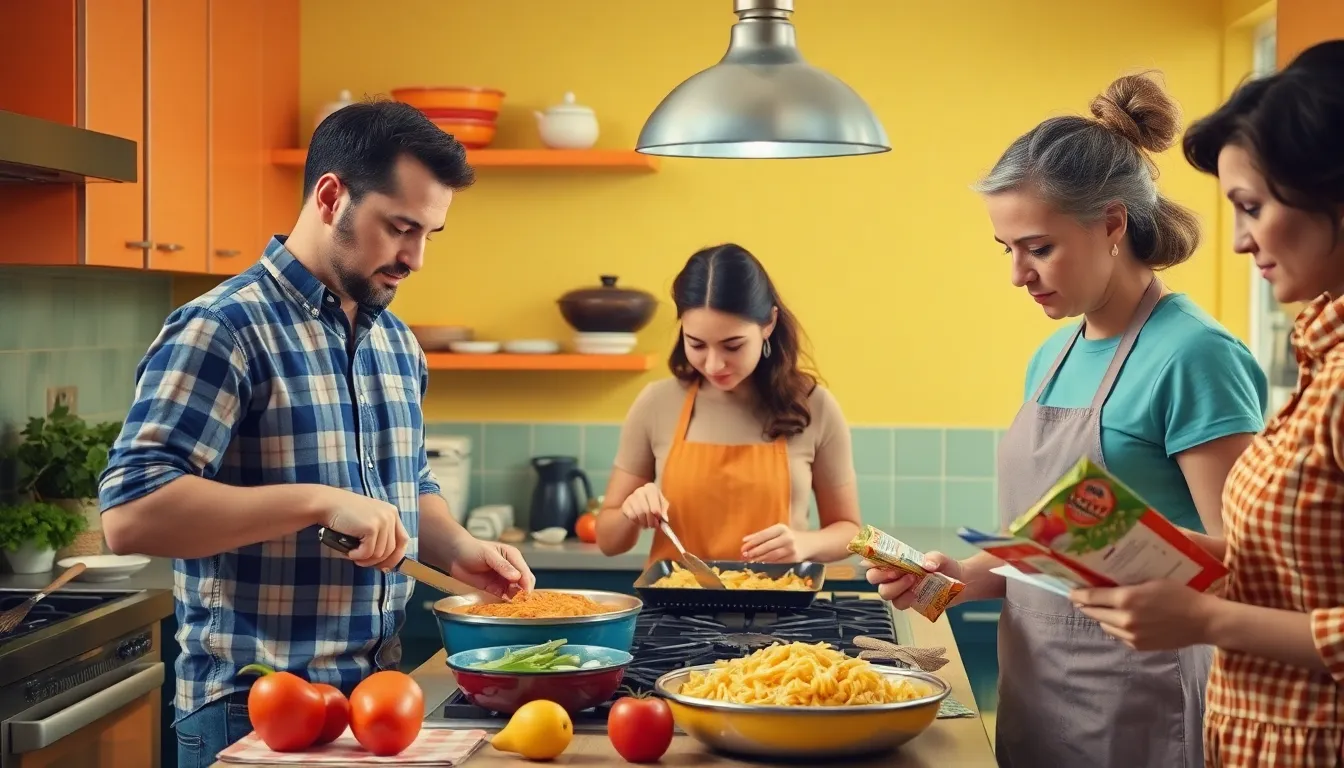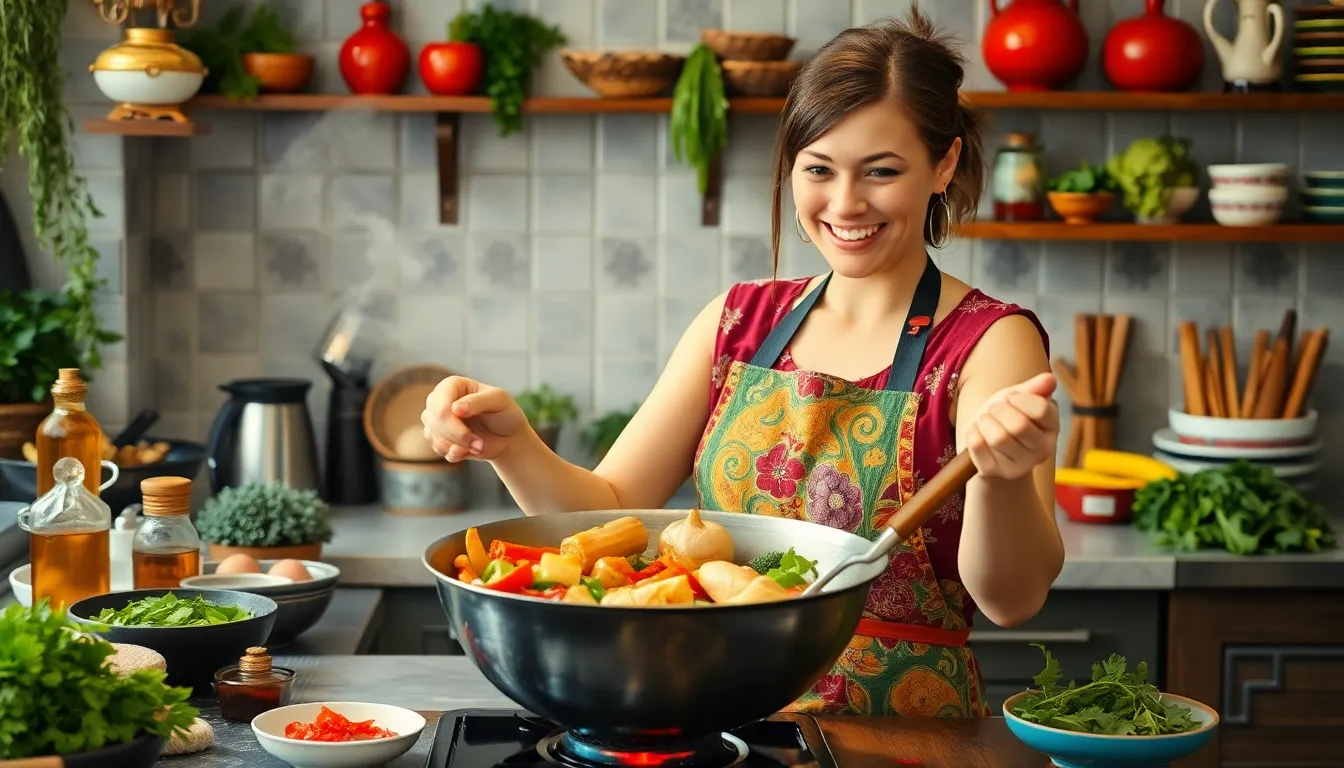Navigating the culinary world with celiac disease can feel like a high-stakes game of dodgeball, where gluten is the relentless opponent. But fear not! Celiac-safe meals are here to save the day and keep taste buds dancing without the risk of a gluten showdown. With a little creativity and some clever substitutions, anyone can whip up delicious dishes that are not only safe but also utterly satisfying.
Table of Contents
ToggleUnderstanding Celiac Disease
Celiac disease affects millions worldwide, causing severe reactions to gluten. It’s crucial to understand its implications for meal planning.
What Is Celiac Disease?
Celiac disease is an autoimmune disorder triggered by the ingestion of gluten. This protein, found in wheat, barley, and rye, leads to damage in the small intestine. Individuals with celiac disease experience an abnormal immune response when exposed to gluten. Over time, this inflammation can harm nutrient absorption. Following a strict gluten-free diet remains the only effective treatment for managing the condition.
Symptoms and Diagnosis
Symptoms of celiac disease can vary greatly among individuals. Common signs include diarrhea, weight loss, and fatigue. Other symptoms may consist of bloating, abdominal pain, and skin rashes. Diagnosing celiac disease typically involves blood tests followed by intestinal biopsies for confirmation. Early diagnosis significantly improves outcomes, as it allows for timely dietary changes, preventing long-term health complications. Regular consultations with healthcare professionals guide effective management of the disease.
Importance of Celiac-Safe Meals

Celiac-safe meals play a crucial role in the lives of individuals diagnosed with celiac disease. These meals not only ensure safety but also enhance overall well-being.
Health Benefits
Consuming celiac-safe meals significantly improves digestion and nutrient absorption. With a strict gluten-free diet, individuals often experience reduced symptoms like diarrhea and fatigue. Additionally, properly managed gluten intake can lead to weight stabilization and increased energy levels. More importantly, adhering to a gluten-free lifestyle can prevent long-term complications, such as intestinal damage and related health issues. Overall, focusing on nutritious gluten-free ingredients fosters healthier eating habits, contributing to better physical and mental health.
Avoiding Cross-Contamination
Avoiding cross-contamination is essential for maintaining a gluten-free environment. Separate cooking utensils, cutting boards, and serving dishes should be designated specifically for gluten-free foods. Regularly scrutinizing ingredient labels ensures all products are celiac-safe. Additionally, dining out requires clear communication with restaurant staff to confirm that meals are prepared in a gluten-free manner. Taking these precautions significantly minimizes the risk of unintentional gluten exposure, promoting a safer culinary experience for individuals with celiac disease. Emphasizing diligence in food preparation habits leads to confidence and comfort at mealtime.
Types of Celiac-Safe Meals
Celiac-safe meals encompass a variety of options that are both nutritious and delicious. These meals ensure individuals with celiac disease can enjoy a diverse diet without the risk of gluten exposure.
Breakfast Options
Smoothies made with gluten-free ingredients provide an excellent start to the day. Oatmeal made from certified gluten-free oats serves as a hearty choice, topped with fruits and nut butter. Eggs, whether scrambled, poached, or in an omelet, deliver high protein. Fresh fruits, such as berries and bananas, support healthy digestion. Gluten-free pancakes or waffles prepared with almond or coconut flour satisfy cravings while staying safe.
Lunch Ideas
Salads featuring leafy greens, colorful vegetables, and lean proteins make for crisp, refreshing lunches. Quinoa bowls stacked with beans, avocado, and salsa offer filling, gluten-free options. Lettuce wraps filled with grilled chicken or turkey ensure a satisfying meal without bread. Rice paper rolls filled with shrimp or tofu and fresh herbs provide a light, flavorful choice. Soups prepared with gluten-free broths, loaded with veggies and protein, serve as comforting meals.
Dinner Recipes
Grilled fish or chicken seasoned with herbs and served with roasted vegetables creates a simple yet elegant dinner. Stir-fries made with gluten-free soy sauce and a mix of colorful vegetables deliver a quick and nutritious option. Pasta made from rice or lentils tossed in homemade sauce satisfies pasta lovers without gluten. Tacos served in corn tortillas filled with grilled meats or beans highlight bold flavors while being gluten-free. Casseroles using gluten-free grains and lean proteins offer filling meals that can be shared with family.
Key Ingredients for Celiac-Safe Meals
Selecting the right ingredients is crucial for crafting meals free from gluten. Celiac-safe meals rely on specific grains, proteins, and vegetables to ensure safety and enjoyment.
Gluten-Free Grains
Quinoa serves as a fantastic alternative to traditional grains. Along with quinoa, rice and millet offer versatility for various dishes. Certified gluten-free oats provide texture in breakfast options while buckwheat adds depth to savory recipes. Amaranth is another nutritious choice rich in protein and fiber. Choosing these gluten-free grains ensures adherence to dietary restrictions while enjoying flavorful meals.
Safe Proteins and Vegetables
Lean meats, such as chicken and turkey, feature prominently in celiac-safe diets. Fish, including salmon and trout, also serve as excellent protein sources. Eggs offer versatility in breakfast and lunch dishes as a simple option. Vegetables like spinach, bell peppers, and carrots supply essential nutrients and flavors. Incorporating a variety of these proteins and vegetables allows individuals to create balanced meals without the risk of gluten exposure.
Tips for Preparing Celiac-Safe Meals
Preparing celiac-safe meals requires careful attention to detail and ingredient selection. Following these tips ensures enjoyable and safe dining experiences.
Meal Planning Strategies
Balance gluten-free ingredients in meal planning. Focus on incorporating certified gluten-free grains like quinoa, brown rice, and millet for nutritious choices. Rotating proteins such as chicken, turkey, fish, and eggs brings variety to the menu. Adding colorful vegetables like bell peppers, spinach, and broccoli enhances flavor and health. Consider batch cooking gluten-free options to simplify weeknight meals. Planning snacks with fruits and gluten-free nuts maintains energy levels.
Kitchen Safety Tips
Eliminating gluten cross-contamination is vital for celiac-safe meal preparation. Using separate cutting boards and utensils for gluten-free foods prevents accidental exposure. Cleaning countertops and surfaces with gluten-free cleaning supplies reduces risks. Storing gluten-free products on dedicated shelves safeguards against contamination. Labeling food containers helps to quickly identify gluten-free items. Communicating with household members about celiac safety raises awareness and strengthens precautions. Consistent adherence to these kitchen safety practices maximizes protection against gluten exposure.
Celiac-safe meals are essential for those living with celiac disease. By embracing creativity and making informed ingredient choices, individuals can enjoy a diverse range of delicious dishes without the fear of gluten exposure.
The journey toward safe dining doesn’t have to be daunting. With proper planning and awareness of cross-contamination, anyone can create meals that not only meet dietary needs but also tantalize the taste buds.
Fostering a gluten-free lifestyle is about more than just avoiding gluten; it’s about enhancing overall well-being and enjoying food once again. By prioritizing celiac-safe options, individuals can thrive while savoring every bite.




